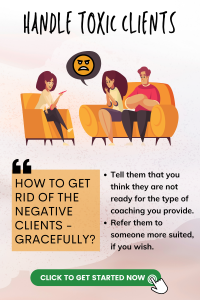With professional behavior in the workplace, there’s nothing more you can do to resolve the situation if the only answer is to say goodbye.
Don’t look at it as a failure on either part. It’s NOT a personal rejection. It’s just a common, everyday part of doing business.
But when should you attempt to salvage a client relationship or retain a member?
And how do you know it is time to let someone go?
Here are seven red-flag signs:
-
Clients who are abusive.
We know: You’d think this wouldn’t be a problem for coaches while having professional behavior in the workplace, but toxic people can’t help it. They inevitably display toxic behavior with everyone.
-
When they think they own you.
Any client who says things like, “I’m paying you good money to blah, blah, blah” needs to go. Period.
-
Clients who bad-mouth you or blame you in public.
This includes comments on social media, at events or even within your membership site or group. (You will usually find this is the client you have made concessions for or who hasn’t brought these issues up with you first!)
-
Who continually and habitually make excuses.
Clients who never do the work and blame it on somebody or something else is not ready for your services no matter how you show professional behavior in the workplace – ditto with chronically and eternally late clients.
-
Clients who affect your health.
If the thought of seeing a particular client makes your stomach hurt, makes your blood pressure rise or knocks you flat without energy, this is a sign you need to fire them because something about them is toxic to you.
-
Clients who argue with everything you teach or preach.
This is a sign that either the client thinks she knows better than you or that she has no faith in you and no respect for your expertise. Or both.
You’ll never ‘win’ with such a client, and you don’t need the negative effect such arguments have.
-
Clients with unrealistic expectations.
Another type of toxic client that you won’t hear much about is chronically needy. They expect you to be their counselor, trauma therapist, best friend, and savior, all rolled into one as you show professional behavior in the workplace.
If you have bypassed the Discovery Call process, you may find yourself saddled with one of these types of clients.
Fire this type of client firmly but kindly.
Tell her you feel that she is not ready for the type of coaching you provide or that you feel she needs to deal with her most prominent emotional or life issue first. To soften the blow, you can refer her to someone more suited, if you wish.
For example, if you have a membership site or group geared to those not yet ready for coaching while having professional behavior in the workplace, this can come as a solution that relieves her.
Some people will tell you to refer clients to a specific, different coach.
Never recommend someone else just to pass the buck and get that toxic client off your back.
Only recommend if you feel another coach would be a perfect fit, and never promise that coach will have room for them on their schedule. The best idea is to ask the other coach before you ever have that conversation with the client.
If you recognize any of these red flags, you should address them immediately. If you don’t know how to do it gracefully, you don’t have to figure it out yourself.
The EBA Profit Planner, “Handle Toxic Clients”, will help you step-by-step on what to do and how to approach it.
The tiny system takes you by the hand to handle toxic clients.
It’s a fluff-free process you can implement right away.
To learn more about the EBA Profit Planner, “Handle Toxic Clients”, check it out here.














